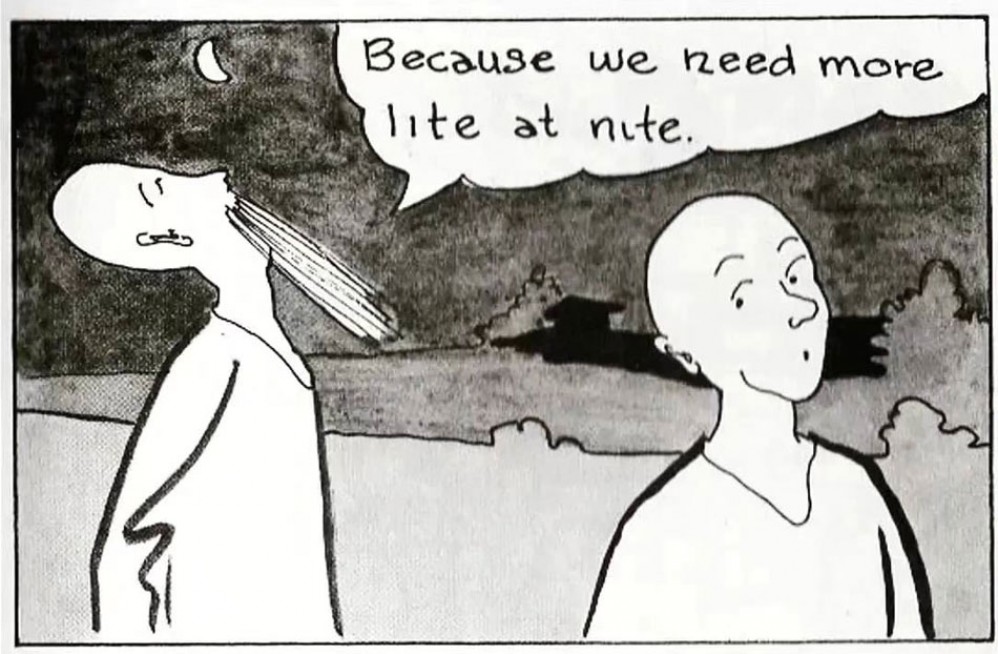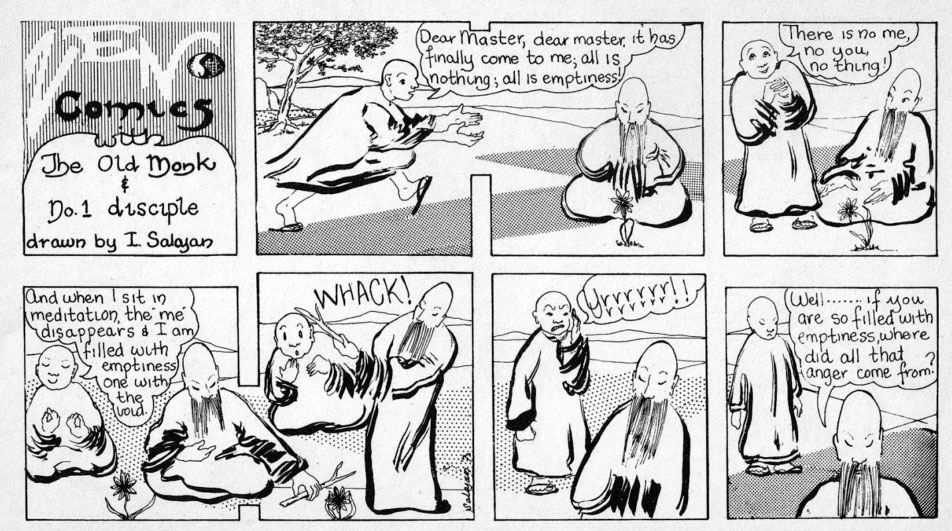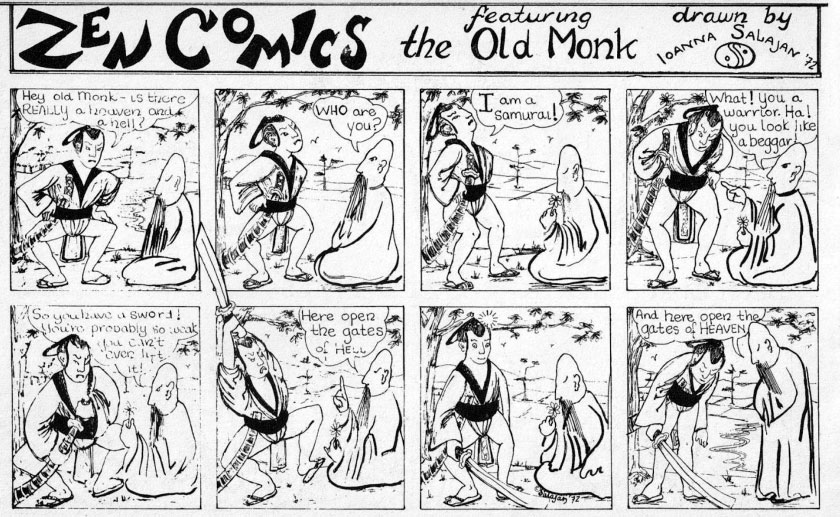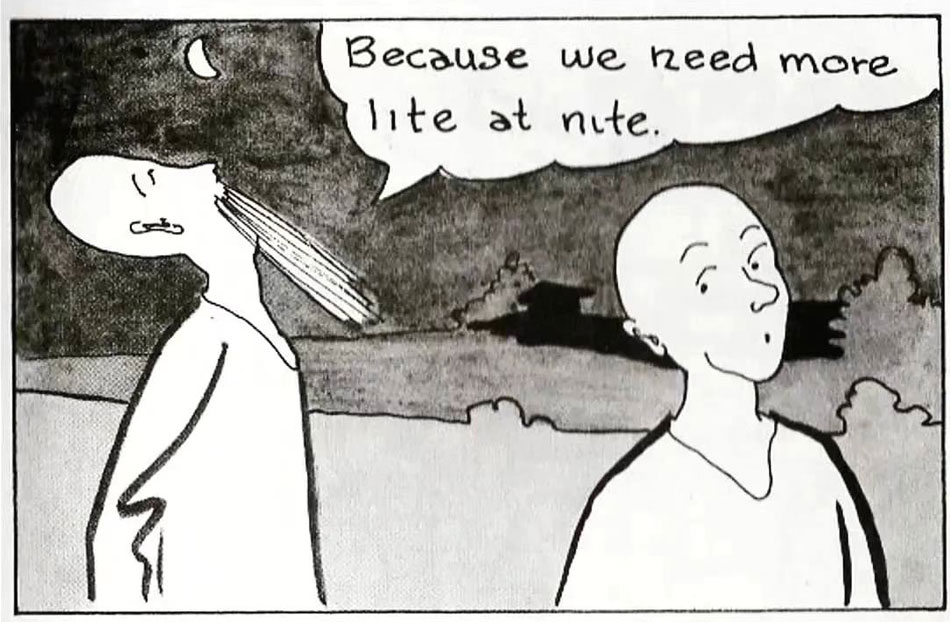Ioanna Salajan was an American-Dutch meditation/art teacher, astrologer and painter. She was editor and illustrator for The Cosmic Paper, the house magazine of the Amsterdam meditation center De Kosmos. In its pages, she published various humorous comics promoting Zen Buddhism under the title 'Zen Comics' (1972-1975). These comics were also published in book format and translated into several languages. Later in life, Salajan moved to Spain, where she continued her work as a meditation teacher.
Early life and career
Ioanna Salajan was born in the United States. The afterword of her book 'Zen Comics' mentions that she was 18 in the late 1950s, making her birth year to either 1939, 1940 or 1941. From a young age, Salajan enjoyed painting and studied at the Philadelphia Academy of Fine Arts. In 1959, she traveled to Europe, visiting Greece, Italy, Switzerland, Israel, Belgium, The Netherlands and Spain. She worked several odd jobs, including painter, art restorer, teacher, archaeologist and light show artist.
Zen Buddhism
Long before it became trendy in the West, Salajan took an interest in South East Asian mysticism, religion and philosophy. In 1959, she visited Joseph Fox's bookstore in Philadelphia, where she discovered Paul Rep's book 'Zen Flesh, Zen Bones', which literally fell from the shelf on her head. The work dealt with Zen Buddhism, a topic that intrigued her enough to actually take a course under Zen master Roshi John Garrie. He remained her guide until his death in 1999. Another influential teacher was the Polish mystic Stefan Lubienski, a student of the famous pedagogue Rudolf Steiner.
By the mid-1960s, Indian, Chinese and Japanese culture and philosophy broke through in the Western mainstream. The Beatles visited India twice, with John Lennon and George Harrison in particular becoming very interested in Hinduism, Taoism and Buddhism. They included its concepts in their lyrics, while Harrison learned to play sitar. For a while, the group followed the teachings of guru Maharishi Mahesh Yogi. Thanks to The Beatles' global popularity, people all across the world now embraced South East Asian philosophy. The Hare Krishna movement became more popular, while several people took up yoga, meditation and listening to mesmerizing sitar music. Ioanna Salajan now found a larger, more receptive audience for her interest in Zen Buddhism and soon became a Zen teacher herself. In the late 1960s, she settled in Amsterdam, where she introduced Bach flower homeopathic remedy centers, organizing courses and private sessions. In 1991, she and S. Cornelissen published an instruction manual for these Bach flower remedies, 'Werkboekje voor de Therapie met de Bachbloemenremedies' (Ankh-Hermes, 1991).
Zen Comics
By 1972, Salajan was working for the meditation center De Kosmos in Amsterdam, which printed a bilingual magazine, Cosmic Paper, offering articles in both Dutch and English about Zen Buddhism and other alternative lifestyles. She was the magazine's editor, designer and lay-out person, livening up the pages with extra illustrations. Other graphic artists active for this magazine at the time were Italo Giordani, Joan Ramón Guzmán, Tadashi Kato, A. Leewis, Germán Maestu, Isabel Moltó, Pasquale, Josep M. Pallisa, Jaume Roselló, Martí Riera and Manuel Rubiales. Around this time, Salajan also illustrated an edition of Ram Rass' text 'Be Here Now'. She also drew 'Eco Comics' (1973) presenting environmentally friendly advice in comic strip form. The 'Eco Comics' were made as advertisements for a Belgian company promoting healthy food.
One night, Salajan dreamt of interactions between an old wise monk and his disciple. She recalled waking up at 3 A.M. with the idea: "Hey, Zen would make a great comic!" and immediately went to her drawing table to whip out a gag. This eventually grew into Cosmic Paper's own comic strip, 'Zen Comics'. Each issue featured one or two episodes.
One of the main cast members is an old, wise monk, sometimes drawn with a Fu Manchu-style mustache, other times with a long beard. Three different young pupils appear in the gags. One is a bald young man, the other has an eyepatch and the third is a long-haired girl. Several episodes follow a gag comic format, but the dialogues are "koans", pieces of dialogue representing an aspect of Buddhist teaching. The enthusiastic young pupils ask their "Master" for spiritual guidance and enlightenment, or they are tested by their guru. Typically, they are left with strange, vague, confusing or, at best, plain simple answers. On rare occasions, the disciple does receive insight. Other episodes of 'Zen Comics' are two-page short stories.
Readers paid Salajan a great compliment by telling her that her comics made the essence of Zen readily accessible to a general public. A book publication couldn't stay behind and in 1973 the printing company Kaal made 'Zen Comics' available in a limited edition on recycled paper. It became a bestseller in the underground press and was also distributed in Belgium, Germany, The United Kingdom and The United States. As Amsterdam was already a Mecca for traveling hippies in search of legal marijuana and underground comix, many of these tourists bought a copy of 'Zen Comics' along the way. In 1974, Salajan contacted the Tokyo publisher Charles E. Tuttle to take over much of the bureaucratic paperwork. Soon 'Zen Comics' was also published by Ankh-Hermes in Denmark, Finland, Italy, Spain, Portugal, Japan, South Korea and Thailand. One Zen student from Switzerland wrote Salajan that her Zen master Seung Sahn – who was Korean – learned English through Salajan's comics.
'Eco Comics' presents ecology tips, by Ioanna Salajan (1973)
Final years and death
In 1975, Ioanna Salajan appeared in a 16mm short film, 'Life Style/Untitled' by independent filmmaker Tom Chomont, recording him, her and her partner Richard Lamm while they are meditating in the Belgian city of Bruges. Interviewed by Scott MacDonald in his book 'A Critical Cinema: Interviews with Independent Filmmakers, Vol. 1' (University of California Press, 1988), Chomont talked about this film, saying that Lamm and Salajan convinced him that one could also have hallucinatory experiences while meditating, which intrigued him since he always thought that LSD and mescaline were the only ways to achieve such visions and he was far too reluctant to take these kind of drugs.
In 1980, Salajan moved to Spain, where she lived on the Balearic islands of Ibiza and Mallorca, remaining active as a painter and meditation teacher. One of her pupils was science fiction writer Rachel Pollack, who also wrote issues of the DC comic book series 'Doom Patrol', drawn by Scot Eaton, Richard Case and Linda Medley.
In 2011, Ioanna Salajan died from ovarian cancer in a hospital in Palma de Mallorca, Spain.







